HISTORY TIMELINE OF THE
UNITED STATES LIGHTHOUSE SERVICE
The Eleven Colonial Era Lighthouse
1716 Colonial-era lighthouses were constructed by individual colonies or municipalities. These towers were often constructed of wood, rubble stone, or a combination of both. The lighthouse on Little Brewster Island in Boston Harbor is given the honor of being officially considered to be the first colonial light. It was completed in 1716 and destroyed in 1776 during the American Revolution. A new tower was built in 1783, and this tower is still standing and active today.
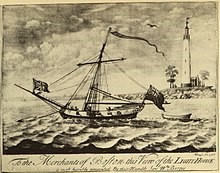
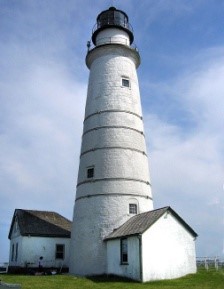
The 1716 Boston Light The 1783 Light
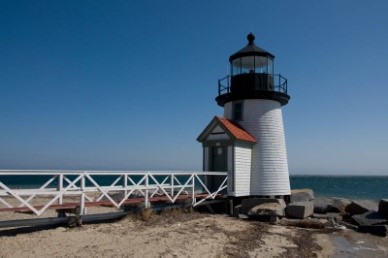
1746 Brant Point (Nantucket Island, Massachusetts) The first lighthouse on the site was completed in 1746 and was destroyed by fire in 1758. The current tower, the tenth light at this location, dates from 1901.
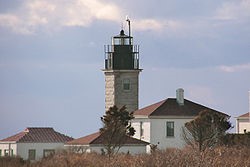
1749 Beavertail Lighthouse (Jamestown, Rhode Island) was at first a wooden tower constructed in 1748 and called the Newport Light. It burned down four years later and was replaced by a stone tower. The current lighthouse was completed in 1856.
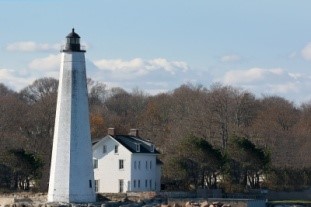
1760 New London Harbor (Connecticut) The tower was demolished and replaced in 1801. This tower is still standing and currently active.
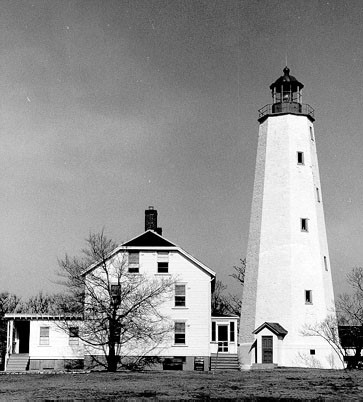
1764 Sandy Hook Lighthouse (New Jersey) The only surviving original colonial-era lighthouse, Sandy Hook is still in active use today.
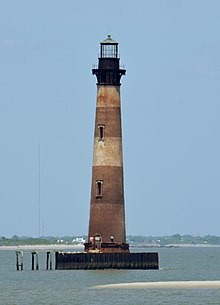
1767 Charleston Lighthouse (Morris Island) Completed by the Colony of South Carolina in 1767, the Charleston Light was first replaced in 1838. The current tower was built in 1876 and was discontinued in 1962 due to erosion. A new tower was commissioned at Sullivan's Island on the north side of Charleston Harbor in 1962.
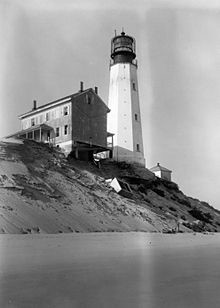
1767 Cape Henlopen (Delaware) Completed in 1767 and first lit in 1769, the Cape Henlopen Light was greatly damaged during the Revolutionary War. Repairs were made, but structural problems and erosion made it clear that the light was in danger. It was discontinued in 1924 and the tower finally collapsed in 1926.
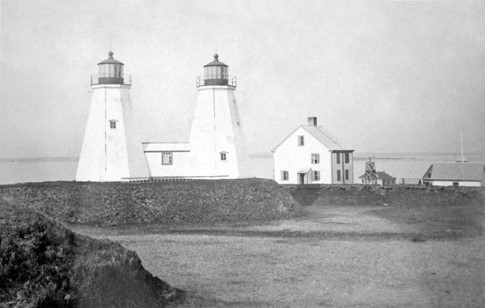
1768 Plymouth Twin Lights (Gurnet Point, Massachusetts) The first lighthouse was a wooden keeper dwelling with a beacon light at each end of its roof. The twin lights were used to distinguish the lighthouse from the nearby Boston Light. The twin lights were destroyed by fire in 1801, and in 1803, twin lighthouses 30 feet apart were constructed to replace the original structure. These lights were soon deemed to be too close together to be distinguishable from a distance, and they were eventually replaced in 1842 by another set of twin towers. In 1924, the northeast tower was torn down and the remaining tower was given a new flashing characteristic. The tower is no longer an active lighthouse.
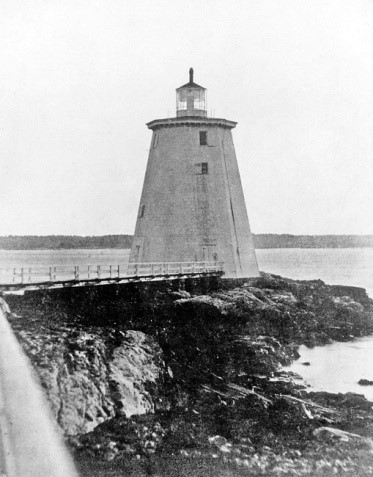
1771 Portsmouth Harbor (New Castle, New Hampshire) A hexagonal wooden tower was constructed on the order of Governor John Wentworth in 1771. Pictured here is an 1804 replacement tower which was built nearby. The tower was shortened in 1851 and in December of 1854 a fourth order Fresnel lens was installed. In 1877 the tower was replaced by a cast-iron lighthouse. In 1887, the tower's daymark was changed from white to brown and in 1902 it was changed back again to white. The beacon underwent a change from fixed white to fixed green in 1941.
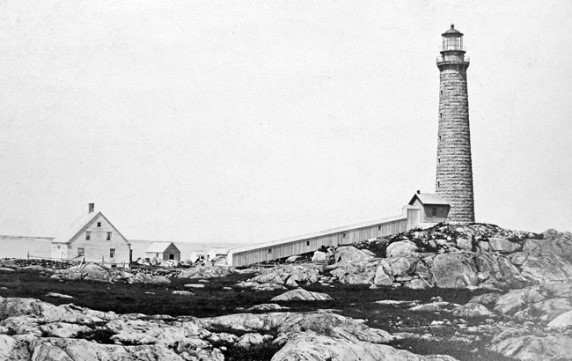
1771 Cape Ann /Thatcher Island (Cape Ann, Massachusetts) Twin towers, 300 yards apart, were activated in December of 1771. Winslow Lewis installed his newly developed lighting system in one of the towers and its brilliance in comparison to the other light earned him his first government contract. In 1860, the original towers were removed. Replacement towers illuminated with first order Fresnel lenses were activated the following year. The north tower was discontinued in 1932. The north tower was eventually restored and now functions as a private aid to navigation. The south tower is still operated by the Coast Guard.
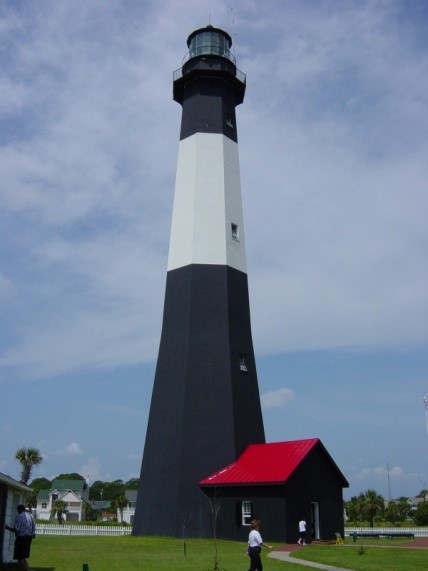
1773 Tybee Island (Savannah, Georgia) A daymark tower was completed in 1736 but collapsed during a 1741 storm. A replacement tower was also lost and a third tower was completed in 1773. In 1822, a shorter tower was built nearby and the two functioned as range lights. In 1857, both towers were fitted with Fresnel lenses. After the Civil War, the main lighthouse was restored and expanded. The shorter tower was replaced by a 50-foot skeletal tower, also equipped with a Fresnel lens. The main light was heavily damaged by a hurricane in 1871, and it was never replaced. The skeletal tower was replaced by a shorter, sturdier tower in 1877. The lighthouse is now owned by the Tybee Island Historical Society.
The United States Light-House Establishment
- When the United States emerged from the Revolutionary War, control of lighthouses was in the hands of individual states. Each state built and maintained its own lighthouses.
- 1789 The United States Light-House Establishment (USLHE) was created. By the ninth law passed by Congress in the newly independent country, control of lighthouse construction and management passed from the states to the Treasury Department. Financing of all navigational aids was to come from general revenue rather than specific light taxes as before. The date of the law's passage was August 7th, which is now National Lighthouse Day.
- 1789-1792 The secretary of the treasury now directed all lighthouse work.
- 1792 The first eclipser was installed in Cape Cod Lighthouse. This was the first use of a flashing characteristic in a US lighthouse.
- 1792-1802 The office of commissioner of revenue was created in the Treasury Department. The commissioner of revenue controlled all lighthouse work.
- 1789-1842 Inspection, construction, and supply of all lighthouses was performed by contractors.
- 1792 The first lighthouse to be constructed in its entirety by the United States was the Cape Henry Lighthouse in Virginia. The government had completed a lighthouse at Portland Head in Maine, but that structure was funded and begun by the state of Massachusetts.
- 1793 The country's first lightship was approved by George Washington.
- 1802 The commissioner of revenue office was abolished and from 1802-1813, Albert Gallatin, Secretary of the Treasury, assumed direct control of all lighthouses.
- 1810 Winslow Lewis, a Massachusetts sea captain and engineer, patented a lighthouse lighting system based on Argand lamps paired with parabolic reflectors.
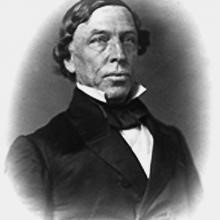
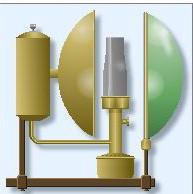
Winslow Lewis Lewis lamp with lens and reflector
- 1812 The US Congress purchased patent rights to the Winslow Lewis lamp system and contracted with Lewis to provide the lamps for all US lighthouses.
- 1813 Control of aids to navigation was returned to the commissioner of revenue. From 1789-1820 the number of lighthouses increased from 12 to 55.
- 1815 Winslow Lewis gained the contract to provide oil and supplies for all US lighthouses on the Atlantic coast.
- 1820 Fog bells were first mentioned in the records. These were used to alert mariners when lighted beacons were obscured by fog or bad weather. Aids to navigation came under the control of the Fifth Auditor of the Treasury, Stephen Pleasonton. Pleasonton was a thrifty administrator whose main goal was to cut costs no matter how poorly constructed a lighthouse might be. He also authorized the use of beacons sold by Winslow Lewis. The Lewis lamp was a design "borrowed" from a lamp designed by Aimee Argand which Lewis "enhanced" with poor quality reflectors and thick, light-obscuring lenses.
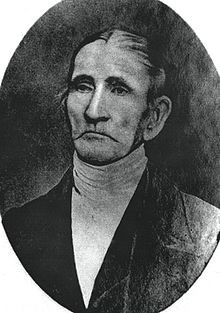
Stephen Pleasonton
- 1822 Frenchman Augustin-Jean Fresnel developed the lighthouse optic that would be named for him – the Fresnel lens. First used in France, the technology soon adopted by many other countries. Stephen Pleasonton continued to use the lighting system developed by Winslow Lewis even though mariners proclaimed the Fresnel lens system to be far superior.
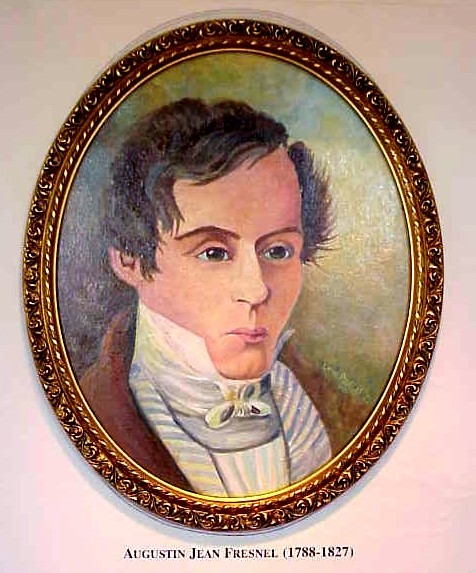
- 1823 The first US lightship was established at Craney Island near Norfolk, VA. Lightships were used off-shore in areas where it would be impossible to construct a lighthouse.
- 1835 A Winslow Lewis lighthouse was constructed on the south shore of Florida's Mosquito Inlet. This lighthouse was never lit and toppled into the water in 1836 after a series of storms. This was one of many instances where construction methods approved by Winslow Lewis were coming under fire for being shoddy.
- 1838 By act of Congress, the Atlantic Coast was divided into 6 lighthouse districts and the Great Lakes coasts into two districts. A naval officer was assigned to inspect each district. The US Senate became interested in investigating the Fresnel lens apparatus being used so successfully in Europe's lighthouses.
- 1839 The first US list of navigational aids for mariners was published.
- 1840-41 The first lighthouse tender that was not a contract (leased) vessel was the RUSH, a sailing vessel transferred to the USLHE from the Revenue Cutter Service. A pair of Fresnel lens were imported and installed at the twin Navesink Lighthouses. A second order fixed light was installed in the north tower, and a first order rotating Fresnel lens was installed in the south tower. The optics performed well in this initial experiment with Fresnel lens technology in the United States. There were now 234 lighthouses, 900 lesser lights, and 30 lightships in operation.
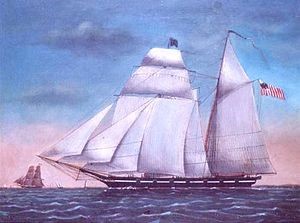
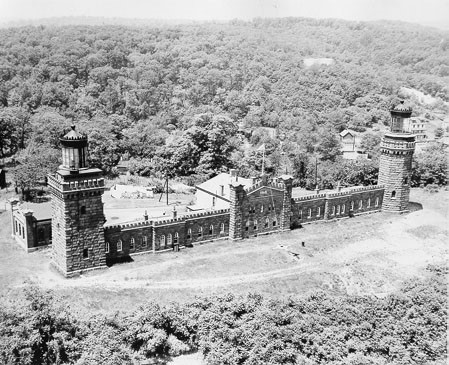
The Rush would have looked similar
to this Revenue Cutter Style Navesink Twin Lights
- 1850 Winslow Lewis died in May. Serious investigation began into the performance of Stephen Pleasonton in the management of lighthouses and his reluctance to embrace Fresnel lens technology. The secretary of the treasury was granted the legal power to appoint local collectors of customs to oversee lighthouses and navigational aids as necessary.
- Systematic coloring and numbering of buoys was implemented.
- 1852 The Light-House Board was formed to oversee the United States Light-House Establishment. The board consisted primarily of military men. The USLHE underwent some professionalization and the country was divided into 12 districts each supervised by an officer of the Army or Navy. A system of classifying navigational aids was begun, and individual paint schemes were adopted to create identifying daymarks for lighthouses. Lighthouse optics were converted to Fresnel lenses, and by 1859 the US government had purchased enough French-made Fresnel lenses, especially from the Lepaute and Sautter firms, to convert nearly every US lighthouse. Stephen Pleasonton was retired.
- 1859-60 The Light-House Board established a central supply depot in the Third District at Staten Island, and gradually supply depots were created in each district. A new official, the district engineer, was designated to aid the district inspector in maintaining and building new lights. The board also began publishing rules and regulations for personnel as well as lists of all aids to navigation in each district. A method of updating the lists, called Notice to Mariners, was also created.
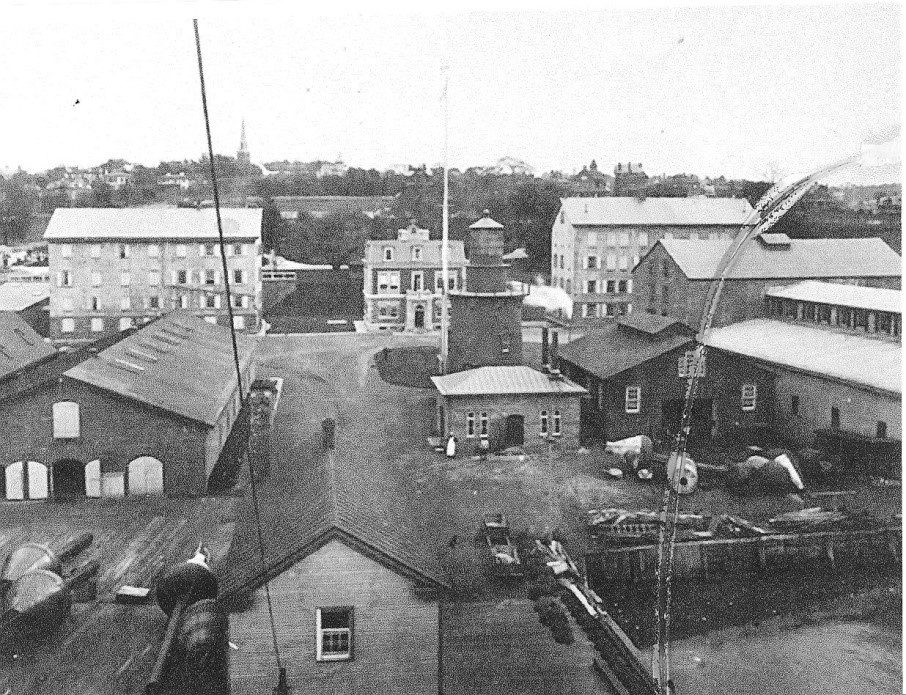
The Lighthouse Depot at Staten Island, 1885
- 1864-1867 Lard became the official oil for lighthouses, replacing colza oil and sperm oil.
- 1865 The tradition of naming lighthouse tenders after trees, flowers, or plants was begun. Tenders were the vessels that carried supplies, work crews, and officers of the service to various lighthouses, as needed.
The lighthouse tender Wistaria
- 1867 Lightships were given identifying numbers, beginning with the letters LV which stands for light vessel. The ships were also given names that generally referred to their location, such as Frying Pan Shoals. When a lightship had to be brought in for repairs, a substitute vessel with the temporary name Relief was sent as a short-term replacement.
- 1869 Light lists were now published annually.
- 1876 The library box program was begun and first used on lightships. Later, the boxes were also sent to lighthouses. Each box contained a different mix of books including technical manuals, religious material, poetry, classics, novels, and more. Library boxes were exchanged during the quarterly inspections and provided keepers and families with the opportunity to read several hundred books annually. (The Ponce Inlet Lighthouse provides a classroom activity suitable for elementary grades based on the USLHE library boxes. A reproduction library box, accompanied by a museum docent in lighthouse keeper garb, is sent to a school where the docent then gives an interactive presentation. The box remains in a classroom where students can be guided by their teacher to explore and learn from the contents before it is returned to the museum. For information about this program, contact the museum's programs manager at 386-761-1821, ext. 18.)
- 1877 Kerosene came into use as a lighthouse fuel by the Light-House Establishment. One of the largest kerosene storage houses ever built by the USLHE was completed at Mosquito Inlet in 1887.
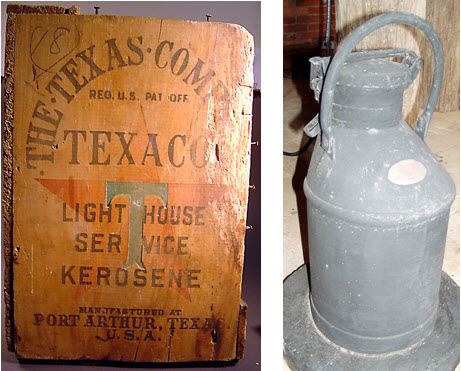
Kerosene was delivered to the Mosquito (Ponce) Inlet Lighthouse during its early years in 5-gallon cans or in boxes containing two 2 ½ gallon tins
- 1881 At this time there were still 12 lighthouse districts.
- 1883-1884 Uniform regulations were decided upon and keepers were required to wear these standardized uniforms. By 1885, most keepers had complied. The basic uniform consisted of a double-breasted blue wool jacket, blue pants, vest, white shirt, black belt and shoes, short black tie, and a navy blue cap with an embroidered insignia. A white linen or cotton duck uniform and a white hat were available for hot weather. A work "uniform" could be denim overalls plus a blue chambray collarless shirt and the blue hat.
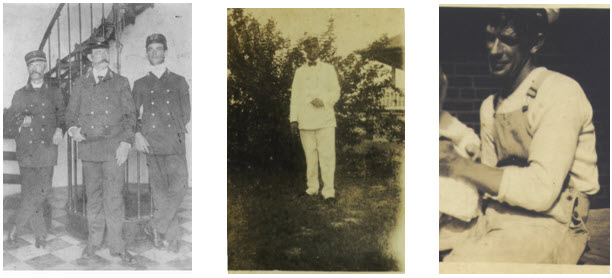
- 1884 The US government purchased 10 acres of land at Florida's Mosquito Inlet for what would eventually become known as the Ponce de Leon Inlet Light Station.
- 1885 Engineer Herbert Bamber created a unique scaffold system for use in constructing the brick giant lighthouse at Mosquito Inlet. Bamber's "working platform" transformed the way all tall masonry structures were built.
Bamber's description of his working platform The working platform in use at Mosquito Inlet
- 1886 The Statue of Liberty became the first electric lighthouse in the US. Commencing in this year, officers and crews of lightships and lighthouse tenders were entitled to free treatment and care by the Public Health Service on the application of their commanding officers, an arrangement that did not become a formal agreement until 1913. As of July 26, 1886, there was an increase in the number of lighthouse districts to 16. On
August 31, the Great Charleston Earthquake struck the east coast causing significant damage to lighthouses from Key West to New York State. The Mosquito Inlet Lighthouse was under construction at the time, but no damage was reported by the work crew on site at the time. erbert Her
- 1896 Lighthouse keepers became part of the civil service, removing those jobs from the realm of political influence and appointments.
- 1897 David Heap, the engineer of the Third District Lighthouse Depot at Staten Island, invented the first acetylene gas powered buoy light. The use of pressurized gas was further improved by Swedish industrialist Gustaf Dalen. In 1905, Dalen also invented a sun valve that regulated the amount of gas used. When the rising sun warmed the valve, it would close off the flow of gas to the burner. After sunset (or during storms), the cooling air temperature would allow the valve to open, igniting the pilot light and allowing the burner to function.
- 1903 The USLHE was transferred from the Treasury Department to the newly created Department of Commerce and Labor. This new department was created by President Theodore Roosevelt.
The United States Lighthouse Service
- 1909 An incandescent oil vapor (IOV) lamp was installed in the first order lens at the Mosquito Inlet Lighthouse, and the original five concentric wick kerosene lamp was removed. The new IOV lamp burned gasified kerosene.
- 1910 Congress abolished the Light-House Board in an effort to "de-militarize" the service and created in its place the Lighthouse Bureau to oversee the officially renamed United States Lighthouse Service (USLHS). The new Lighthouse Bureau had a commissioner, a deputy, a chief constructing engineer, and a superintendent of naval construction, and more civilian members than the previous board. The old Light-House Establishment was reorganized, allowing the creation of more districts, but the number of districts was not to exceed 19. Each district was to be headed by an inspector who was to be a civilian. A two year grace period was given to accommodate the military men who were already serving as district inspectors. The first commissioner of lighthouses was George R. Putnam, who served until 1935 and was considered to be a phenomenally effective leader.
- By 1911, the USLHS reconfigured the districts. Mosquito Inlet was now included in the Seventh District after being in the Sixth District since its construction.
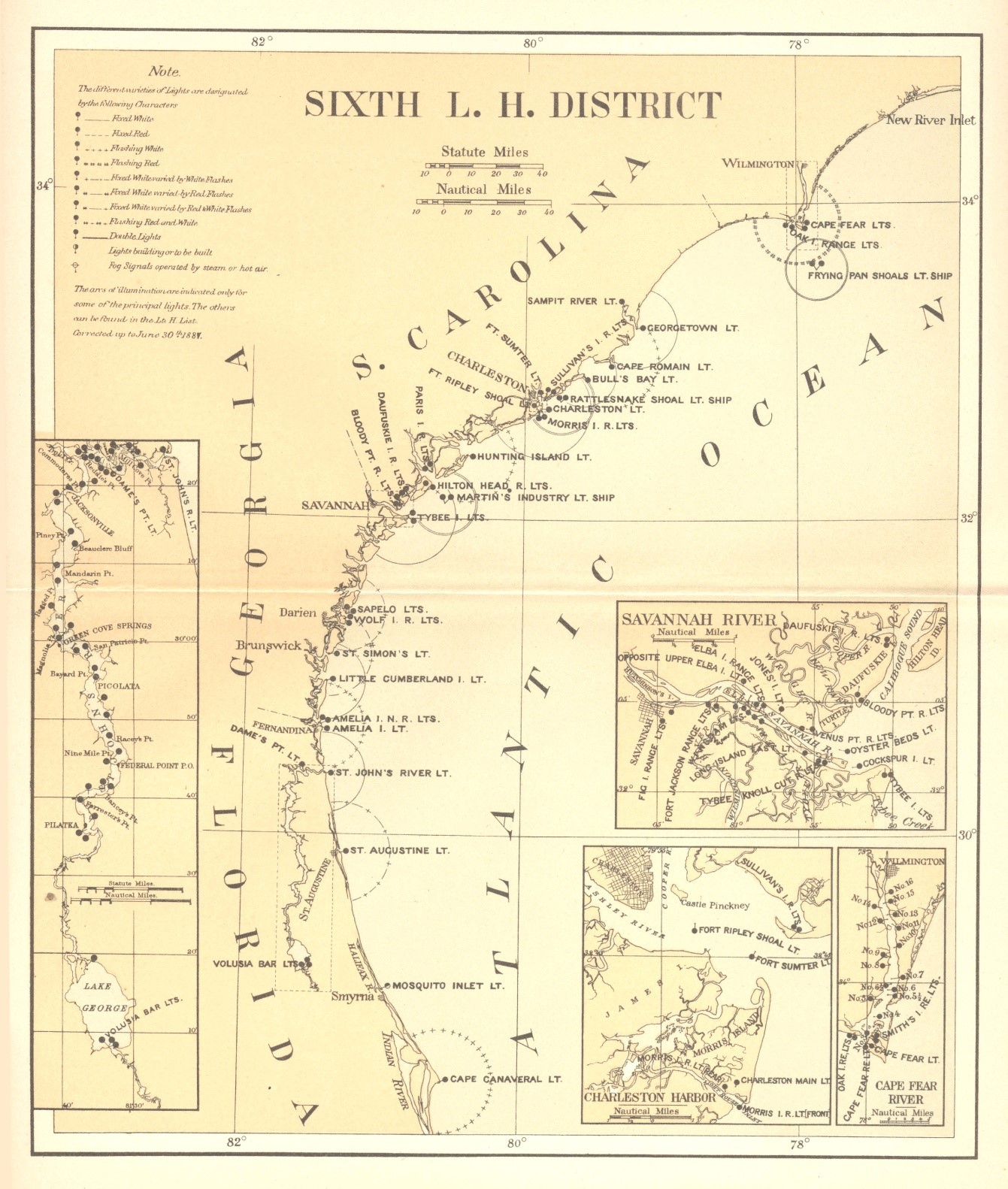
Published before the 1910-1911 district changes, this map shows
the Mosquito (Ponce Inlet) Lighthouse in the Sixth District
- 1913 Lighthouse vessel crews were formally entitled to free health care by the Public Health Service. The Department of Commerce and Labor was divided into the Department of Commerce and the Department of Labor by President Taft.
- Early 1900s Lighthouses were gradually becoming electrified. Around 1916, automatic lamp changers appeared and by the 1920s were being used in some lighthouses. These devices would automatically rotate a fresh bulb into place at the lens focal plane when one burned out.
- 1915 In response to growing conflict in Europe, the United States Coast Guard was formed by merging the Revenue Cutter Service, the Bureau of Navigation, the Steamboat Inspection Service, and the Life-Saving Service.
- 1916 Health benefits were instituted for keepers and Lighthouse Service personnel.
- 1917-1919 The United States Coast Guard and the Lighthouse Service came under the command of the Navy until after the First World War. The lighthouse district inspectors came to be known as superintendents (June 20, 1918) in a gradual change of title that took place during the war years. As of June 1918, keepers and employees received retirement and disability benefits – the first civil service to gain such benefits. The government installed telephones and telephone lines to connect all Coast Guard stations and important lighthouses.
- 1919 The Lighthouse Service was returned from the Navy to the Department of Commerce.
- 1921 Longevity pay was established for Lighthouse Service vessel crews.
- 1921 Sea Girt Lighthouse, New Jersey, became the first land-based lighthouse equipped with a radio beacon navigation system conjoined with the Ambrose Channel and Fire Island lightships to transmit radio signals that enabled ships at sea to pinpoint a vessel’s position by the triangulation of the three signals.
- 1924 A new system of classifying lighthouses and of determining new salaries for employees at each classification was established. Lighthouse Service employees were granted disability benefits.
- 1926 -27 Mosquito Inlet was renamed Ponce de Leon Inlet during the Florida Land Boom, hoping to make the area sound more attractive to investors. The light station name was also changed to Ponce de Leon Inlet. The USLHS Airways Division was founded to assist in the production of "lighthouses for airplanes" and airport and runway lighting.
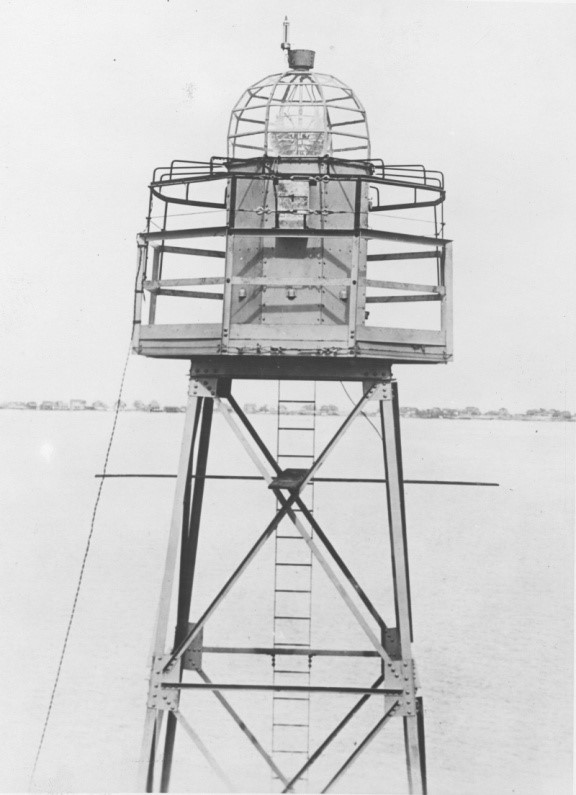
Located at Norfolk, Virginia, in the 1920s, this aviation
"lighthouse" guided aircraft at night and during bad weather
- 1928 The first radio beacon at a lighthouse was installed at Virginia's Cape Henry Lighthouse.
- In 1933, the Department of Commerce was reorganized. The USLHS Airways Division was folded into the department's Aeronautics Branch and put under the control of the Assistant Secretary for Aeronautics.
- 1938 A transition began and became official on 7-1-1939: the Lighthouse Service was absorbed into the Coast Guard. Keepers were given the option to retire, to remain as civilians attached to the Coast Guard, or to become part of the Coast Guard, usually at the rank of Chief Petty Officer. In 1938, a new Coast Guard facility, CG Station Ponce, opened across the inlet from the Ponce de Leon Inlet Light Station. The Coast Guard was now in charge of all US and US held aids to navigation.
- During World War II, the Coast Guard was under Navy control.
- During the war, radio beacons were established at many lighthouses. At Ponce Inlet, the radio beacon was installed in 1939, prior to America's entry into the war.
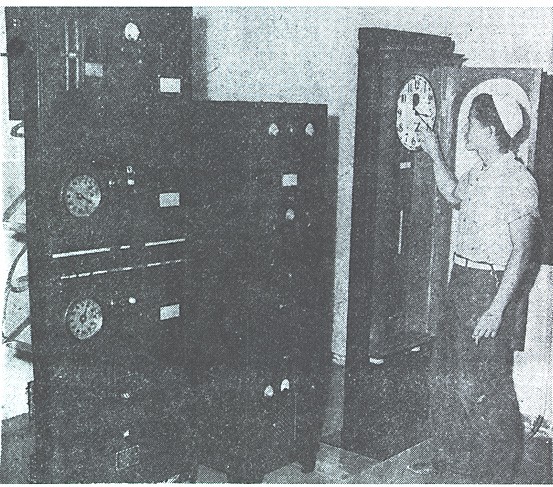
The radio beacon at the Ponce Inlet Lighthouse, c. 1943
- 1946 On January 1, the oversight of the Coast Guard was returned to the Treasury Department.
- After World War II there were 14 Coast Guard districts.
- 1953 The Ponce de Leon Inlet Light Station was fully automated and the need for resident keepers came to an end.
- 1970 The Ponce de Leon Inlet Light Station's beacon was discontinued on January 1, 1970. It was reactivated by the Coast Guard in 1982, and in 2004 the beacon became a private aid to navigation, maintained by the Ponce de Leon Inlet Lighthouse Preservation Association.
- 1972 The Town of Ponce Inlet acquired the Ponce de Leon Inlet Light Station and the Lighthouse Preservation Association was formed to manage the site.
- 1973 Two more districts were added to the Coast Guard.
- 1987 The number of districts was reduced to 10.
- As of May 30, 1996, there were nine Coast Guard districts. Their number designations and headquarters were: 1 Boston, 5 Portsmouth VA, 7 Miami, 8 New Orleans and St. Louis, 9 Cleveland, 11 Alameda CA, 13 Seattle, 14 Honolulu, 17 Juneau.
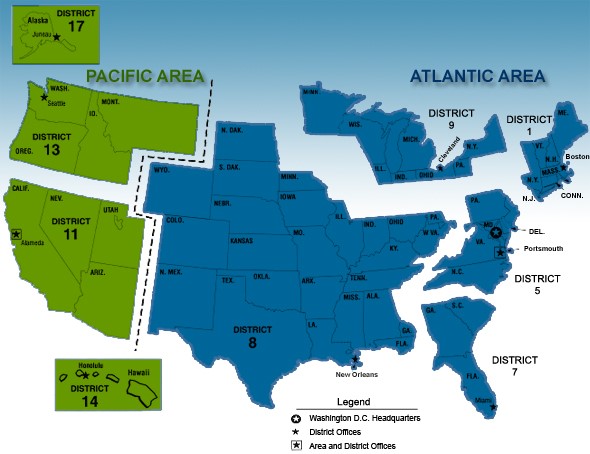
Current 9 CG Districts: 1, 5, 7, 8, 9, 11, 13, 14, 17


